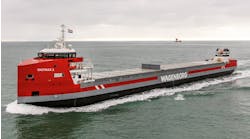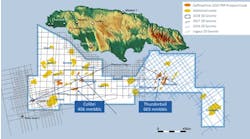Lack of pipelines prompt gas conversion consideration
Frank FrazerA growing inventory of gas reserves in Atlantic waters is prompting exploration groups in north-west Europe to study prospects for commercial recovery from deep and distant locations with no existing pipeline infrastructure.
Contributing Editor - Scotland
The need for solutions has been given added emphasis by British Petroleum's discovery of a promising gasfield while drilling Norway's first deep-water well earlier this year on a structure called the Nyk High. According to the Norwegian Petroleum Directorate, preliminary estimates suggest the field might be about half the size of the North Sea's Frigg discovery which originally had more than 6 tcf of gas reserves.
Encouraged by accompanying traces of liquid hydrocarbons, BP plans to focus further exploration in the area meantime on finding oil reserves which will be more easily recoverable from the location where water depths are nearly 4,000 ft.
But confirmation of significant gas prospects there and in other parts of the northwest European shelf mean that operators cannot ignore the recovery challenges presented, particularly because disposal proposals will have to be devised for gas which is found in association with oil, even if there is no rush to develop gas and condensate discoveries.
The need to examine technical and commercial aspects of gas recovery led to the recent formation of the Aurora group by Texaco, Conoco, and Total to conduct a joint study into prospects in the UK waters west of Shetland, which is the most intensely explored sector of the Atlantic margin to date.
Gas finds there include Texaco's Victory field. Although it is sufficiently near Shetland to make it feasible to consider a pipeline to a landfall such as the tanker terminal at Sullom Voe, gas landed on the islands would subsequently have be piped several hundred miles to reach markets on the UK mainland, either through a new dedicated subsea trunkline or by a link to existing gas-gathering infrastructure in the North Sea.
Texaco executive Elliott Dubuisson, appointed as Aurora project manager, said the joint industry approach could lead to a solution being in place by 2002. "We have to confirm the gas reservoirs, establish development plans and finalize commercial agreements to achieve project sanction by 1999.
The engineering and construction phase is expected to last approximately three years," he added.
Other gas options
While pipeline delivery into the existing UK gas distribution grid seems the ideal solution, other executives involved in the study point out that they are starting with a blank sheet of paper. They do not rule out other possibilities including using the fuel for power generation or taking advantage of fast-developing technology to convert gas into liquid hydrocarbons, either offshore or at onshore plant.Texaco has an agreement to study applications of enhanced gas-to-liquids technology developed by the Tulsa-based Syntroleum from the Fischer-Tropsch process pioneered in Germany in the 1920s. Syntroleum claims its compact units can be packaged for use offshore on platforms or floating production installations.
Calculations by energy analysts at Wood Mackenzie suggest that the economics of gas-to-liquids technology are starting to rival typical investment in liquefied natural gas, which is estimated in the range from $30,000-45,000 per boe per day output. "With gas-to-liquids technology potentially having investment costs in the order of $35,000 per bbl per day down to $25,000 per bbl per day - with the prospect of eventual reductions to $20,000 or even $10,000 - the technology appears potentially very attractive, compared to the cost of an LNG scheme," WoodMac claims.
Gas conversion
There could also be implications for refineries through the ability to fine tune the gas-to-liquids process to yield a premium-priced product mix, a factor which might further improve the attractions of using the technology offshore. But WoodMac also warns that the viability of this option will remain unproven until plant has been put into commercial operation. Norway's Statoil, which has the largest holding of net acreage for Atlantic drilling among exploration groups in Europe, has also shown interest in offshore applications of gas conversion techniques through a deal with Sasol, the South African oil company. The firm also has worked on refinements to the Fischer-Tropsch process.A major study of Atlantic frontier prospects just completed by WoodMac suggests that total gas reserves discovered from drilling to date in the UK, Norway and Ireland amount to about 5.5 tcf. This includes a provisional estimate of 2 tcf for BP's Nyk High find, which is only about two-thirds of the reserves suggested by the Norwegian Petroleum Directorate.
WoodMac estimates that about 2.5 tcf of the total is represented by gas finds in the UK sector in the Atlantic, with the remaining 1 tcf contained in the Colib North discovery made during wildcat drilling last year by Enterprise in about 1,000 ft of water off the west coast of Ireland.
Other forecasts suggest that the Irish find could contain as much as 3 tcf, though Enterprise has made no official estimate after testing to establish productivity from the discovery well. The work was frustrated by a casing collapse which could not be corrected before weather started to deteriorate at the end of the 1996 drilling season.
The company is carrying out detailed three-dimensional seismic on the structure this year and plans to drill again in 1998 to gain knowledge of flow potential before deciding on the commercial prospects for the find. Of all the gas discoveries so far made in the Atlantic, the Colib North Field appears to be the best prospect for early development. It lies just 34 miles offshore and is near shallower water where a fixed platform could be located to handle transfer of gas from subsea wells to a pipeline ashore as a possible development option.
With Ireland facing a deficit in indigenous supplies to meet rapidly-growing gas demand, the political and economic circumstances should be right for near-term investment if commercial recovery potential is confirmed.
Copyright 1997 Oil & Gas Journal. All Rights Reserved.


